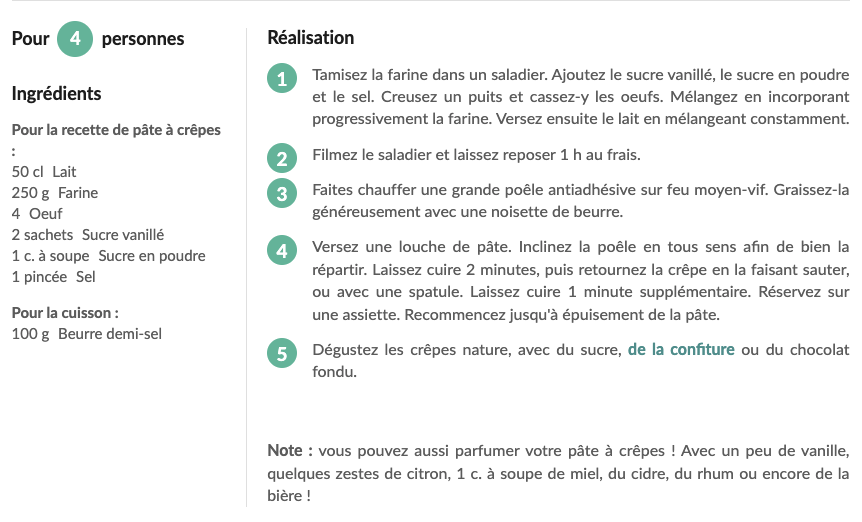Candlemas: how and why?
Candlemas is a traditional Christian holiday celebrated on February 2nd each year, whether it is a leap year or not, the date never varies. It is 40 days after the date of Christmas, on December 25th, the day of Christ's birth according to the church. Candlemas corresponds to the Presentation of Jesus in the Temple in Jerusalem.
Candlemas is also called the Feast of Candles. It is a festival that honours light in all its forms, whether it is the light of day, the light of candles, or the light of divine grace.
La Chandeleur: How is it celebrated?
Chandeleur is of course known for the crêpes that are eaten in every French household. It is customary to flip a pancake in the pan with a coin, originally a Louis d'or, in the left hand. If the crepe falls perfectly flat into the pan, then it is a sign of financial prosperity for the coming year.
It was also customary to place the first crepe folded over a coin on top of the house cupboard to attract good fortune and abundant harvests to the house. The previous year's pancake was then thrown away and the coin given to a beggar or a needy person.
The shape and colour of the pancake is said to represent the sun, the lengthening of the days leading to spring. It is also said, although not proven, that Pope Gelasius I distributed biscuits to pilgrims in Rome on this date in the 5th century.
Although Candlemas is a religious festival, these traditions have found their way into all French families with a sweet tooth on 2 February. However, Christians who go to church to celebrate the Presentation of the Child Jesus in the Temple by Mary in Jerusalem, carry candles or tapers to be blessed. They should then be taken home and placed on the windowsill, lit. This is also the date when the cot is put away.
Candlemas: Christian origins?
Candlemas is therefore the Christian celebration of the Presentation of the Child Jesus in the Temple of Jerusalem by Mary. This biblical episode is reported by Luke in his Gospel.
The presentation of children in the Temple was part of the obligatory actions in the Jewish faith, to which Mary, Joseph and of course the child Jesus belonged. This Hebrew prescription stipulated that every firstborn male child should be consecrated to the Lord. This is a rite of purification. The birth of the child must be redeemed, exchanged for the sacrifice of an animal: two turtledoves or two doves. This text, and in particular the sacrifice of animals, is controversial among exegetes. The purification is said to be that of Mary, who became a mother, and not of the child.
On arriving in the Temple, Mary carrying her child Jesus and Joseph are challenged by two prophetic figures: Simeon and Anna.
Simeon would not die until he knew the Messiah. Driven by the Holy Spirit to the Temple, he sees Jesus take him in his arms and bless him. He tells God that now he can leave this world and die. He reveals to Mary and Joseph that Jesus is the light that will enlighten the Gentile nations and the peoples of Israel.
Anna, an old and extremely pious widow, praises the child when she sees him and tells everyone she meets about this scene and the child.
Candlemas: pagan origins?
The Candlemas festival probably has its roots in pagan festivals, as is often the case with many festivals that were replaced by religious celebrations. The Christian church in Rome did this on several occasions in order to gradually replace the existing rites with Christian ones.
The month of February was the time of many celebrations:
The Celts celebrated Brigit, goddess of fertility and purification, on 1 February. The farmers walked the fields with torches before sowing to purify the land.
the earth. St. Bridget's Day was established on 1 February by the Catholic Church.
A parallel can also be drawn between Candlemas and the bear festivals that are still celebrated in the still celebrated in the Pyrénées-Orientales. The aim is to celebrate the return of vigour and fertility by the bear's emergence from its wintering period. Here again, we can also see that that this day is also celebrated as St Ours d'Aoste and St Blaise. St Blaise is also associated with the candles that were brought to him when he was in prison for his beliefs.
In ancient Rome, the Lupercalia festivals were celebrated at the foot of the Palatine Hill by walking through the streets with sticks. These festivals were an opportunity to praise Faunus (the Greek Pan) who represented fertility.
The festa candelarum was also celebrated, the light brought back to Earth by the goddess Persephone taken from the dark underworld by Hades, the god of the underworld. Her mother Demeter (goddess of wheat, among other things) (goddess of wheat among other things) had obtained from him that her daughter return to Earth two thirds of the year by
bringing her light into our world.
It is also relevant to point out that the word February itself comes from the Latin "februare", a verb meaning to purify, and can also be related to the word fever, which causes heavy sweating and is supposed to purify the body.
Indeed, all these festivals and Candlemas itself carry the same ideas of purification, renewal and return to the light.
And finally, here is a delicious recipe for pancakes!

Make them wherever and whenever you want!
Sources :
https://fetes.toutcomment.com/article/qu-est-ce-que-la-chandeleur-origines-histoire-et-traditions-13460.html
https://www.regal.fr/recettes/desserts/pate-a-crepes-12766
Bon appétit !

